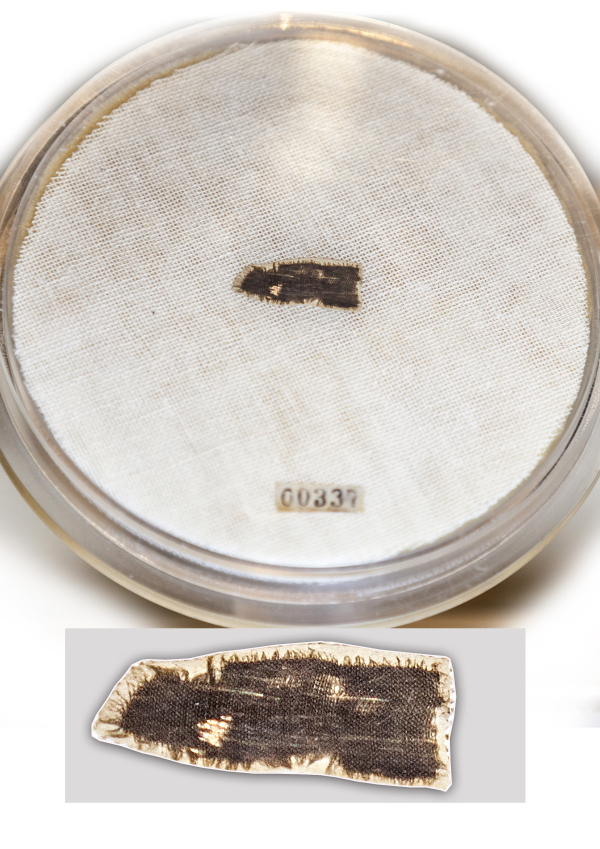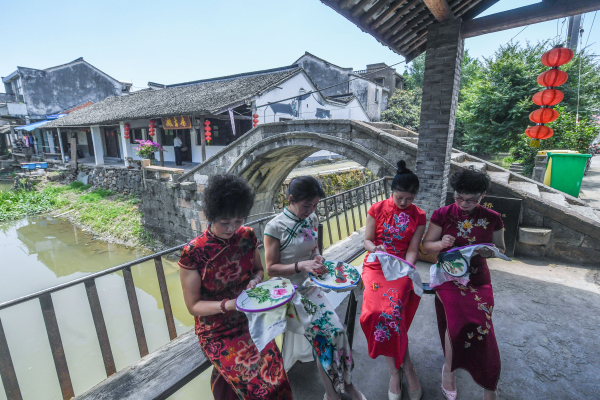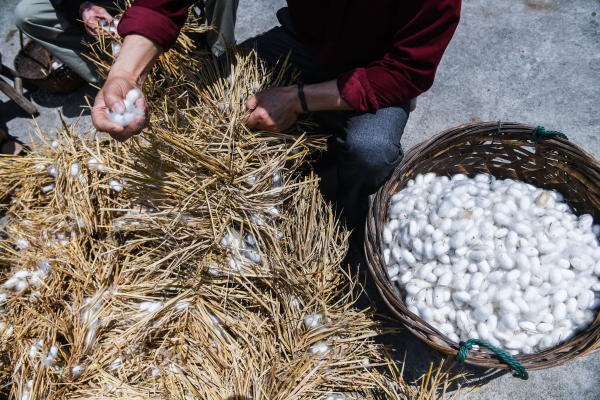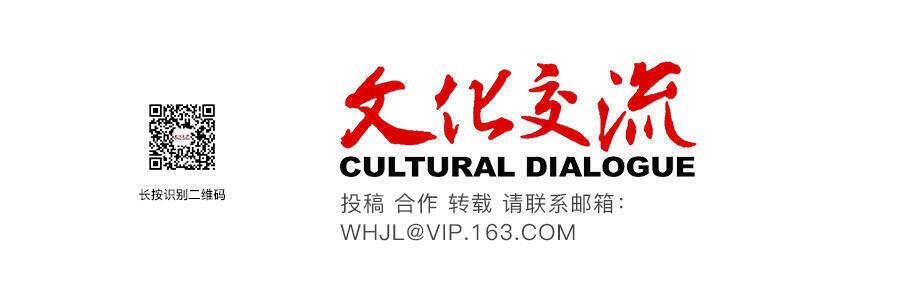The Name and Roots
The ancient network of trade routes called by historians as “Silk Road” stretched from Chang’an in China through India, Asia Minor, up throughout Mesopotamia, to Egypt, North Africa, Greece, Rome and Britain. The routes were formally established during the Han Dynasty (206 BC-220 AD) of China for the Han emissary Zhang Qian to transport goods, including a large amount of silk, to the “Western Regions” to seek allies in hope of whittling down the power of the nomadic tribes of Xiongnu living in the edges of the Pamirs at that time. Silk was also used by Emperor Wu as rewards to the victorious army taking part in the three major wars against Xiongnu.
In the Han times, silk was the most trustworthy hard currency, used together with coins and foodstuff as soldier’s pay and provisions. The Han officially opened trade with the west, encouraging merchants to trade goods with buyers thousands miles away.

With many different kinds of merchandise traveling along the Silk Road, the popularity of Chinese silk reached the west, especially with Rome. By the time of Julius Caesar, silk was the most sought-after commodity in the empire. Cleopatra VII also favored Chinese silk for her formal wear used on diplomatic occasions.
The consequences of Zhang Qian’s journey were a bustling trading “thoroughfare” spanning continents, but it was not until 1872 that the term “Silk Road” was coined by the German geographer and traveler, Ferdinand von Richthofen to replace former references such as “Porcelain Road”, “Jade Routes”, “Buddhism Road”, etc.
Archeological exploration of the Qiansanyang area in eastern Huzhou started in the summer of 1934, when the underwater debris of the lake emerged at the end of a major drought and caught the attention of historians and archeological specialists. The findings in 1958 include uncarbonized remnants of silk fabrics made 4,400-4,200 years ago, revealing a dust-laden secret of Huzhou to the world and proving that the Qiansanyang area in Huzhou is the birthplace of the magic beauty of the mysterious fabric that enchanted the whole world.

The National Treasure
The sericultural glory of Qiansanyang as well as the greater Huzhou region is partly based on the area’s unique farming tradition known as the “mulberry land-pool” farming system that ensures the finest environment for the production of the highest quality of silk. The system is justifiably a heavyweight entry in the world’s most important agricultural heritages.
The silk glory of Huzhou reached its peak in the Ming (1368-1644) and Qing (1644-1911) times, and has never waned. Tucked away in the depths of Ditang, the vast water area stretching from Huzhou into the territory of the ancient town of Nanxun, is a small village called Jili, where the unique quality of soil nourished by a limpid river is ideal for mulberry cultivation and silkworm breeding. The superior quality of Jili raw silk also comes from the locals’ pedal-style silk-reeling machine.

In the Northern Song (960-1127), the vibrant silk industry of Huzhou spawned an official organization that administered silk affairs. Silk products crafted by people in Anji and Wukang became the most sought-after. In the Yuan (1279-1368) Dynasty, silk materials from Huzhou became bestsellers for buyers in Suzhou, Nanjing and the Songjiang area, thanks to the grafting technique used by farmers in Huzhou. The Southern Song times saw the entire Hangzhou-Jiaxing-Huzhou region turning into a spectacular scene of mulberry plantations. Silk made in Jili was recommended to the emperor by Zhu Guozhen and Wen Tiren, both Prime Minister in the Ming Dynasty.
With “made in Jili” becoming the synonym of high quality silk, the Ming and Qing saw the rise of many other silk varieties copycatting Jili silk. In the year 1684, a local official reported a foreign merchant brought Huzhou silk to Europe for trial use.
Huzhou silk was brought to Japan in the Tang (618-907), and used for writing imperial edicts and art creation.
Silk Legacy in Nanxun
Taking a walk in one of the mossy alleys in the ancient town of Nanxun and passing by a girl in silk , you’d feel you are time traveling back to the Song and Yuan times.
Silks and satins are the symbol of the true nature of Huzhou – elegant, graceful, aristocratic, and sensuous. It is silk that laid the solid foundation of the long-time prosperity of Nanxun, where the fertile soil and rich water resources ensured by a labyrinth of rivers and streams make the vast plains ideal for sericulture.
The reputation of the fine silk produced in Nanxun reached its peak in the Tang times and lasted long into the Qing. The high quality of the fabric won the hearts of Emperor Xuanzong, Emperor Kangxi, and Queen Victoria, who received Nanxun silk as her birthday gift and loved it so much that she could hardly bear to put the fabric down. The vibrant sericulture of Nanxun also inspired many men of letters.

The Ming and Qing times saw the rise of several “silk towns” that further broadcast the fame of Huzhou silk in the wider world and brought a new, elite clientele for the unique quality of what was marketed as the “Jili silk”. The nine robes of Emperor Kangxi were all made of Jili silk. Emperor Daoguang treasured his silk garments so much that he had to see a wasteful of 3,000 taels of silver spent just to sew up a small hole in his pants. During the heyday of the Huzhou silk industry throughout the two decades between the years of the Emperor Xianfeng and the reign of Emperor Guangxu, an average of 30 million silver dollars poured into money shops in Huzhou every year for the trading of silkworm cocoons and silk products. Many stylish garden residences of silk trade tycoons in Nanxun have remained and offer a glimpse into the legendary wealth they accumulated.
Silk became such a big deal in the royal life of the decades of Emperor Guangxu of the Qing Dynasty that Empress Dowager Cixi ordered a mulberry garden be built inside the Summer Palace to support the operation of a silk-processing factory used exclusively by the royal members. From 1912 to 1928, Jili silk accounted for 38% of the yearly silk export from the ports in Shanghai. Buyers from all over the world came to Huzhou for the silk trade.
The Cultural Ambassador
Silk has been playing an important role in the economic and cultural communication between China and Europe. The Europeans fell in love with this ethereal fabric at first sight. The superior fineness of the navy blue shoes of Napoleon is an interesting illustration of such fascination. However, at a time of strict export restriction due to the rarity of the material, Europeans racked their brains for trading outlets but in vain, until the opportunity finally came in 1849. Queen Victoria sent invitation letters to the world traders for the World Expo scheduled to open in 1851. When the news reached Shanghai, Xu Rongcun, a comprador based in Shanghai sent 12 packs of Jili silk to London. The snow-white silk thread in plain packaging was ignored by the jury for five months before it was opened. The softness and purity of the material immediately won the recognition of all jury members, winning a gold medal for the Shanghai-based trading company and marking a new start in the export of Jili silk to the West.
In a report written by a silk merchant delegation visiting Nanxun in 1857, Nanxun’s bustling silk industry was described vividly as “the air smells like silk”.

Following the opening of Shanghai as an international commercial port in 1842, Huzhou silk rose to account for as much as 90% of the national foreign trade volume. In the 1870s, sixty of the seventy silk companies in Shanghai were run by businesspeople from Huzhou, with the prices of Huzhou silk updated daily on a local newspaper just like stock market quotations today.
The outbreak of the Pebrine disease, a disease of silkworm in the Mediterranean area in the mid-19th Century, brought a delegation of six Italians into Huzhou, where they spent 50 days learning silkworm rearing and silk reeling techniques from the locals.
